children's books
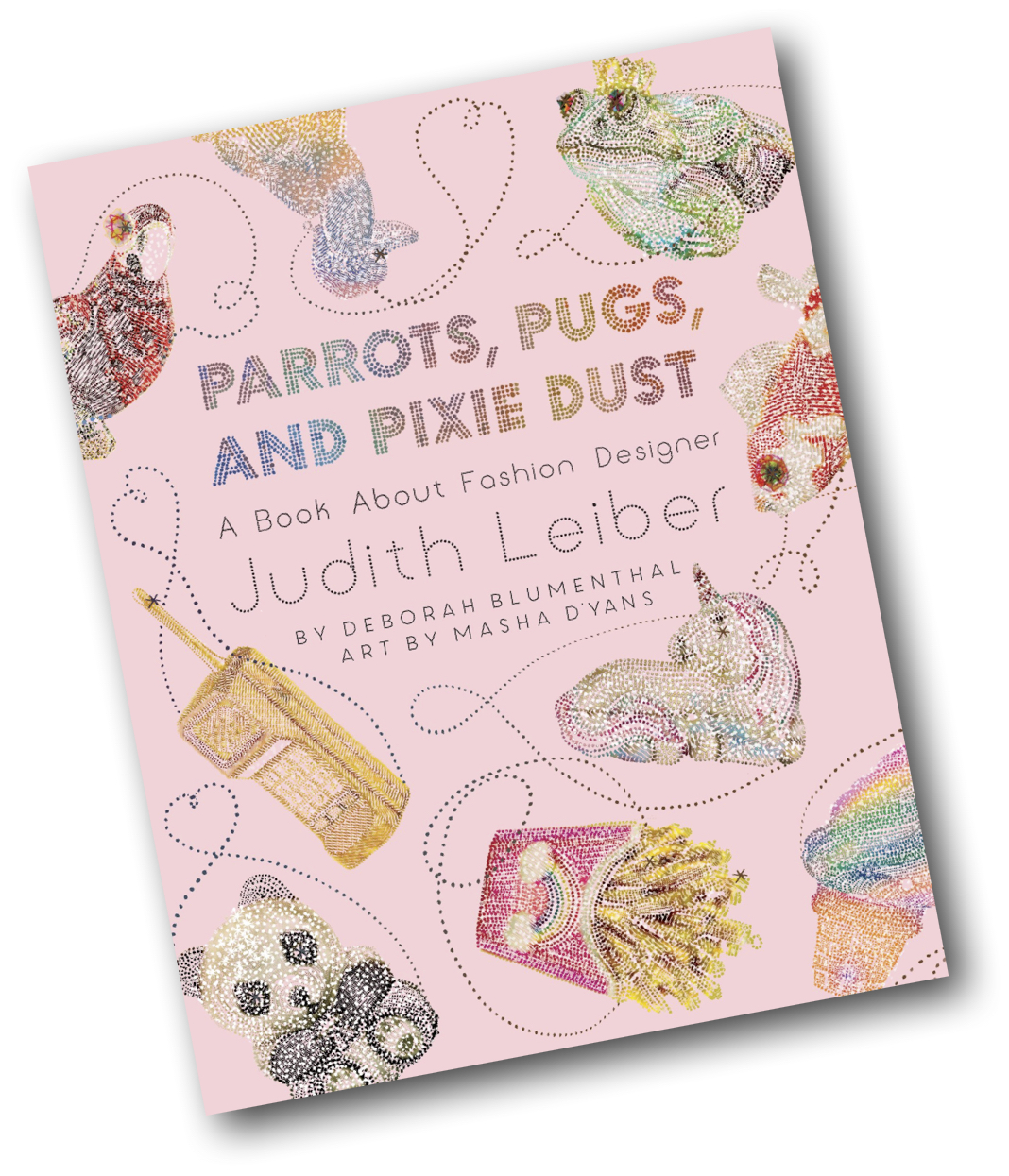
Parrots, Pugs, and Pixie Dust: A Book About Fashion Designer Judith Leiber
by Deborah Blumenthal
Order now from Amazon.com
Order now from Barnes&Noble.com
Order now from IndieBound.org
* Selected as a Sydney Taylor Award Notable Book for 2020
About Parrots, Pugs, and Pixie Dust: A Book About Fashion Designer Judith Leiber
This is a moving and impassioned picture book about iconic handbag designer Judith Leiber that will embolden young readers to use their imaginations and inspire the world with their own creativity!
REVIEWS
Kirkus Review
Judith Leiber designed over-the-top jeweled evening bags that have become cherished collector's items.
She and her family survived World War II and the Holocaust as forced laborers in factories, living in shared apartments with other Jewish families and later hiding in a basement. All the while she kept dreaming of the bags she would make someday. She married an American and moved to New York, where she worked for many handbag companies and then started her own, making her signature bags for the rich and famous. They took the form of animals or food and all kinds of imaginative shapes. Each bag was covered in jewels and crystals in a plethora of shining, gleaming, bright colors. Blumenthal blends biographical facts with glowing, almost breathless descriptions of the unusual, beautiful bags and their celebrated owners. Readers may notice that the chronology is off; they learn that Leiber started her own company in 1963 and then, a few pages later, that Leiber designed Mamie Eisenhower's bag for the 1953 inaugural balls. D'yans' softly hued, slightly fuzzy illustrations depict many of the bags noted by the author and seem to shine as brightly as the bags themselves. Dark, muddy hues appropriately limn the Holocaust years.
Admiration for a unique talent shines as brightly as her jeweled creations in this biographical homage. (author's note, photographs, bibliography) (Picture book/biography. 7-9)
SCHOOL LIBRARY JOURNAL
K-Gr 4-Growing up Jewish in Budapest, Judith Leiber and her family spent much of World War II in hiding. She dreamed of building a career in handbag design. Later, Leiber married Gerson Leiber, an artist, and an American soldier. They sailed to the United States where she forged a new kind of fashion statement: crystal-covered handbags that were also works of art. Her creations gained immense popularity, especially with numerous first ladies. Many of her bags are now displayed in museums. Blumenthal's alliterative text lightly summarizes Judith's life and fashion career. The back matter includes an author's note and bibliography that includes a link to the Leiber collection museum where readers can view the range of her handbag production. Deftly dotted watercolors capture the whimsical nature of the designer's work. Two spreads are filled with bags in surprising shapes-french fries, a walkie-talkie, the parrots and pugs of the title, and more. VERDICT From the pair that celebrated the work of photographer Bill Cunningham (Polka Dot Parade, 2018), this picture book biography will please a similar audience. This unabashedly pink and sparkly title is an artful introduction to an innovative stylist.
-Kathleen Isaacs, Children's Literature Specialist, Pasadena, MD
SHELF AWARENESS
With imagination, skill and perseverance, a young Jewish woman wins her place in the fashion world after surviving the horror of World War II in this nonfiction picture book.
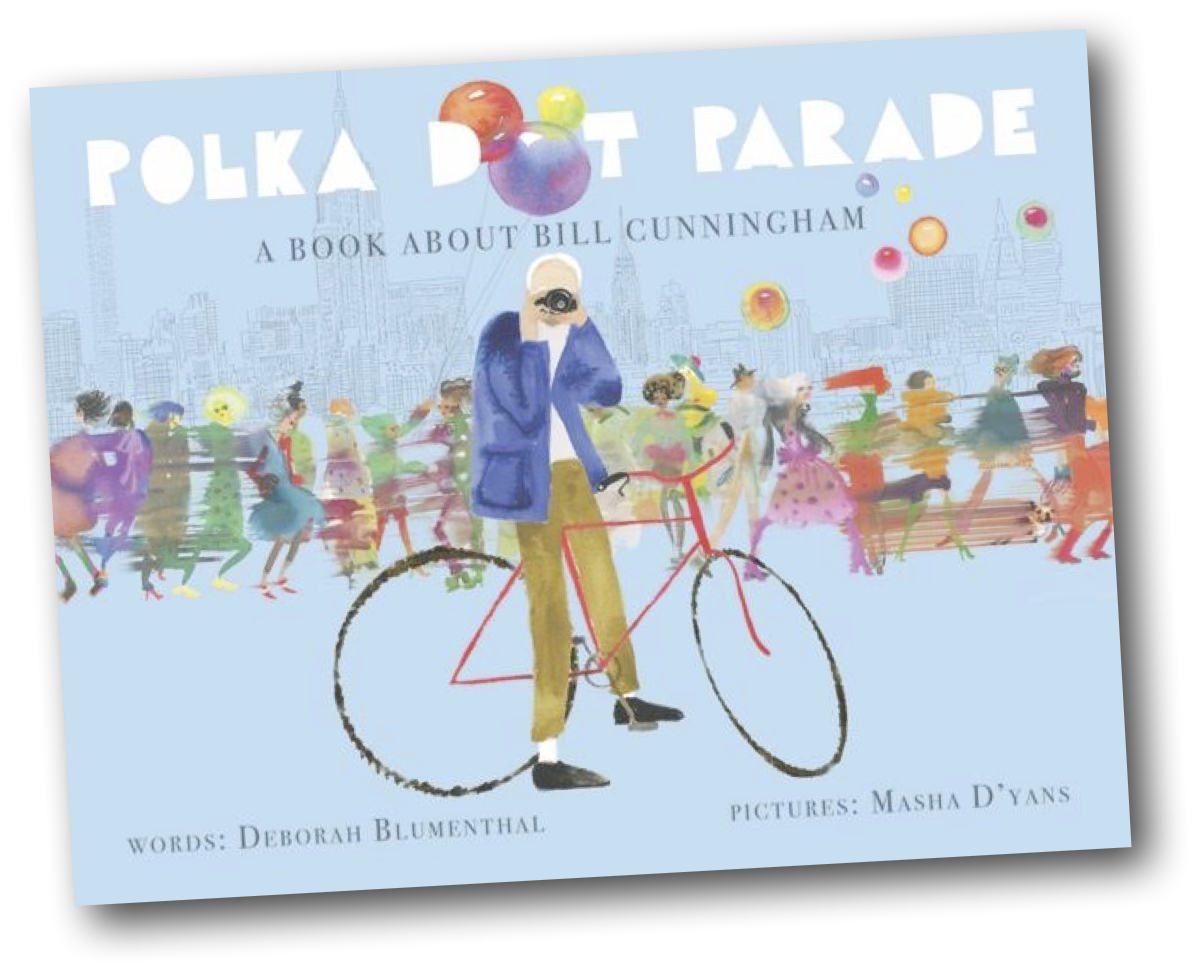
Polka Dot Parade: A Book About Bill Cunningham
by Deborah Blumenthal
Order now from Amazon.com
Order now from Barnes&Noble.com
Order now from IndieBound.org
About Polka Dot Parade: A Book About Bill Cunningham
This picture book biography about the iconic fashion photographer Bill Cunningham will inspire young readers to go discover their own ideas of beauty and embolden the world with their own creativity! He found "sheer poetry" in the drape of an evening dress, delight in the swoosh of a knife-pleated skirt, and sartorial splendor in Jazz Age garb. Every day, Bill Cunningham pedaled his bike through New York City searching for beauty. As he took picture after picture, Bill found beauty not in people, but in their clothes. Drawn to bold and creative choices, Bill's photos captured the attention of the New York Times. He traveled to Paris for Fashion Week, and admiration for his work grew. With his sense of creativity and daringness, his own personal style of photography came to be known as street art photography. His photos left a lasting impression on all those who came across his work and they continue to inspire creativity today. This is the story of the legend who created street fashion photography and left behind a legacy of glorious pictures. Bill Cunningham used his passion and talent to capture the beauty he saw in fashion and the ultimate freedom that it represents to each and every person. This is an inspiring picture book about finding your path and being creative.
REVIEWS
Kirkus Review
Starred Review
A picture-book tribute to fashion photographer Bill Cunningham.
From fashion and beauty journalist and children's author Blumenthal comes a touching tale of one of New York's most beloved and slightly eccentric fashion icons. With his signature "blue French worker's jacket, tan pants, and black sneakers" and a camera "slung around his neck," for decades Cunningham cycled the streets of Manhattan, seeking both the figures who made fashion and those who consumed and put it proudly on display each day. "He who seeks beauty will find it," said Cunningham, the humble hat maker-turned-photojournalist who single-handedly created the genre of street-fashion photography, presenting the images of regular people and models together in his New York Times photo column "like squares on a story quilt." D'yans' scintillating watercolors, depicting Bill in action on the street or his subjects who "looked like leopards in their leopard prints, ...dudes in dots and spots," perfectly match Cunningham's unassuming edginess with their ragged splashes of brilliant color and deft smear technique that creates a three-dimensional illusion of motion. Seasoning her spare text just so with Cunningham's own voice (sourced in notes), Blumenthal effectively communicates her admiration for her subject.
Beautifully rendered and told, the book brings to life the work of a gifted 20th-century artist whose creative vision will always be in vogue. (author's note, bibliography) (Picture book/biography. 4-12)
Publishers Weekly
In keeping with Bill Cunningham's singular fascination with the visual splendor of fashion, Blumenthal and D'yans offer a close-up on the photographer's creative pursuits. With dynamic processions of swooshing colors, patterns, and fabrics, D'yans vividly conveys how Cunningham viewed New York City fashion through his eyes and lens. One figure wears a trailing cloak that features an inky landscape; elsewhere, moths and dragonflies emerge from a woman's gown. Cunningham is portrayed as an impassioned observer who captured the beauty of his subjects in unguarded moments on the street, or from the handlebars of his beloved bicycle. Blumenthal peppers her prose with quotations from Cunningham that speak to his devotion to his art and his celebration of clothing as a true expression of human individuality. Ages 4-8. (Aug.)
Polka Dot Parade is a charming reminder of all the color and joy that Bill Cunningham brought to the world of fashion every day. The industry is not the same without him. Thank you, Deborah Blumenthal and Masha D'yans, for creating this lovely celebration of Bill's mark on the world.
-Christy Turlington Burns, model, health advocate, and founder of Every Mother Counts
Bill Cunningham was a New York treasure and the most beloved photographer and quirky personality in the fashion business. I am so glad Deborah and Masha created this whimsical storybook, exposing our Bill to whole new audience. I miss you, Bill.
-Fern Mallis, Creator of New York Fashion Week
Masha's vivid watercolor work brings Bill's photos to life. A stunning marriage of two forms of art. The eyes are on a holiday. Well done!
-Eric Carle
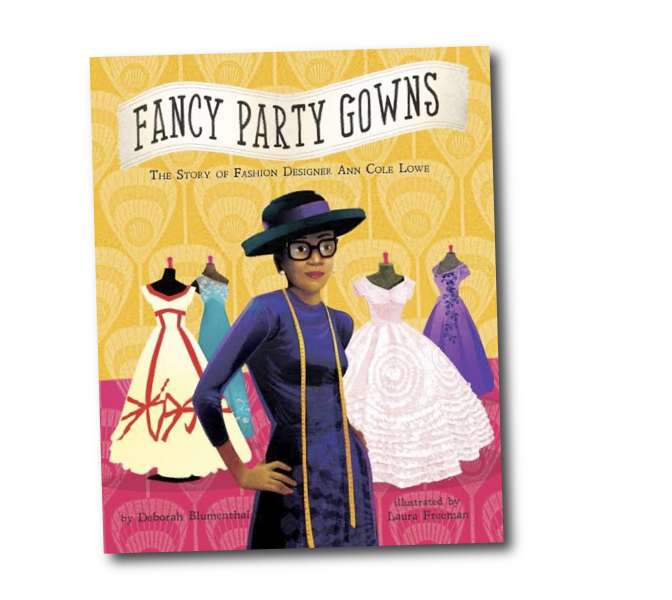
Fancy Party Gowns: The Story of Ann Cole Lowe
by Deborah Blumenthal
with illustrations by Laura Freeman
Order now from Amazon.com
Order now from Barnes&Noble.com
Order now from IndieBound.org
About Fancy Party Gowns: The Story of Ann Cole Lowe
As soon as Ann Cole Lowe could walk, her momma and grandma taught her to sew. She worked near her momma in their Alabama family shop in the early 1900s, making glorious dresses for women who went to fancy parties. When Ann was 16, her momma died, and Ann continued sewing dresses. It wasn't easy, especially when she went to design school and had to learn alone, segregated from the rest of the class. But the work she did set her spirit soaring, as evidenced in the clothes she made, including Jackie Kennedy's wedding dress and Olivia de Havilland's dress at the Oscars when she won for Best Actress in To Each His Own. Rarely credited, Ann Cole Lowe became "society's best kept secret." This beautiful picture book shines the spotlight on a little-known visionary who persevered in times of hardship, always doing what she was passionate about: making elegant gowns for the women who loved to wear them.
REVIEWS
School Library Journal
K-Gr 4 - Virtually unknown to all who admired her work, Ann Cole Lowe was an African American designer of one-of-a-kind dresses that were worn at high society functions in the 1920s through the 1960s. She began sewing as a child under the tutelage of her mother and grandmother, taking over the family business at the age of 16. Lowe moved to New York City and attended a segregated design school, where she was forced to study alone. She was eventually able to save enough money from dress commissions to open her own salon in Manhattan. Here she catered to the elite, creating the dresses for Academy Award winner Olivia de Havilland in 1947 and Jacqueline Bouvier's wedding to John F. Kennedy in 1953. Blumenthal celebrates Lowe's skill and artistic merit-the timelessness of her beautiful, iconic couture gowns. Freeman's gorgeous, colorful illustrations highlight the patterns of the cloth, the tools of the trade, and the emotions of Lowe's struggles and triumphs as a businesswoman. VERDICT A portrait of the determination and elegance of Ann Cole Lowe. Hand to kids who love fashion and history.
-Jessica Cline, New York Public Library
The Horn Book
While the fashion world continues to recognize her work, many do not know the name Ann Cole Lowe. Blumenthal and Freeman have teamed up to place the spotlight on this African American designer. As a young child, Ann learned dressmaking from her mother and grandmother. When her mother died suddenly, sixteen-year-old Ann steadfastly continued the tradition, finishing an order for ball gowns her mother had begun for the Alabama governor's wife. Lowe proved to be an exceptionally talented dressmaker, eventually designing for some of America's most powerful families. With the repeated refrain, "Ann thought about what she could do, not what she couldn't change," Blumenthal encapsulates the designer's resolve. To ensure the line doesn't imply passivity, Blumenthal includes an anecdote about Lowe's insistence on walking through the front door, rather than the workers' entrance, of a Newport mansion to deliver Jacqueline Bouvier's now-famous wedding dress. Freeman has filled the pages with a plethora of vivacious patterns and saturated colors, fitting for a book about a woman so gifted with fabric. The one (intentional) exception is the illustration on the page where the text reads, "But it was 1917, and Ann had to study in a separate classroom, all alone, because she was African American": here the empty white space that surrounds Lowe evokes a palpable sense of isolation. Audiences will take pleasure both in the vibrancy of the dresses and in the dedication of the couture artist who created them. Appended with suggestions for further reading and an author's note.
Kirkus Reviews
Society ladies and screen actresses made Ann Cole Lowe's gowns famous, but no one credited their African-American designer.The great-granddaughter of a slave, Ann grew up in Alabama sewing with her mother. When she was just 16, her mother died, but Ann kept on with the work, finishing a gown for the wife of the governor. She was able to attend design school in New York City in 1917, albeit sitting alone in a segregated classroom. As the proprietor of her own business, Ann was in much demand with very wealthy and high-profile women. Olivia de Havilland accepted her 1947 Oscar wearing an Ann Cole Lowe gown. In 1953, a rich socialite named Jaqueline Bouvier married a Massachusetts senator named John F. Kennedy wearing one of Lowe's couture creations. Lowe worked hard and eventually began to receive long-overdue recognition. Freeman's crisply colorful artwork enlivens the clear and accessible narration. The endpapers featuring pictures of Lowe's runway-perfect gowns and fabric swatches in the page design will delight young fashionistas, while the vignette of Ann in a classroom sitting by herself against a solid white background speaks volumes. Kudos to a title that recognizes a previously uncelebrated African-American woman of achievement.
Publishers Weekly
The twin themes of injustice and hard work are woven into Blumenthal's (The Blue House Dog) vivid biography of African-American designer Ann Cole Lowe, who learned to sew at a young age, took over her late mother's business, and went on to design gowns that included dresses for Jacqueline Bouvier and John F. Kennedy's wedding. Accented with buttons and lace, Freeman's (the Nikki and Deja series) illustrations are attentive to the shape and design of the clothing worn and designed by Lowe, and they glow with a honeyed light that underscores the designer's persistence in the face of racial prejudice. Ages 4-8.
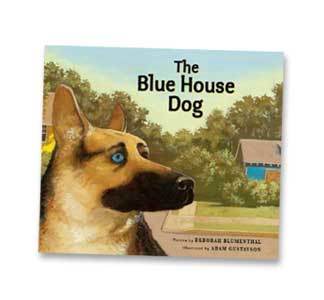
by Deborah Blumenthal
with illustrations by Adam Gustavson
Order now from IndieBound.org
Order Now From Amazon.com
Order
now from Barnes&Noble.com
Winner of the Missouri Show Me Readers Award 2012-2013
Chosen as a 2011 Honor Book
by the Society of School Librarians International (SSLI).
Watch the book trailer on YouTube
About The Blue House Dog
All day and night in sun and rain and snow, a stray dog wanders the streets of a neighborhood after its devoted owner has died. No one takes much notice of the thin, unremarkable animal that some people call Bones. No one except the narrator, a young boy, who takes an interest in the dog's well being.
The boy feeds Bones scraps of meat and watches out for the dog's safety. One day the boy's fast action stops a car from hitting the dog. Bones reminds him of his own dog, Teddy, the one he loved and who died. As the young boy reaches out to help Bones, the dog slowly begins to trust him. The two form a strong attachment that ultimately leads to mutual ownership as each finds companionship and solace in the other.
Readers will be deeply affected by Deborah Blumenthal's story of love, loss, and love regained and will easily empathize with the narrator, sharing his concern for an animal in need. Adam Gustavson's full-color illustrations reveal the shadows and light, as well as the quiet drama, of neighborhood life, and the emerging relationship between the narrator and the lonely, dispirited dog that captures his attention, and finally, his heart.
REVIEWS
Children's LiteratureIn rich and detailed oil colors, The Blue House Dog captures the heartache of loss and the uncertainty of opening oneself up to the prospects of caring and trusting again. Through the eyes of Cody, the narrator, an adolescent boy, and the brown and blue mismatched eyes of Bones, a suddenly-abandoned dog, Blumenthal creates a poignant and touching tale of heartbreak and redemption. Cody has lost his best friend, Teddy—furry, wet-nosed sharer of secrets and late-night blanket tents. Bones has lost his owner and home and now scurries from shadow to shadow, evading the dog catcher while pawing through garbage for scraps. Though the neighborhood pronounces Bones just a stray—and not a special one at that—Cody begins to think otherwise. Over time, he works at overcoming his sadness upon losing Teddy, and gaining the trust of the equally hurting Bones. Young readers, especially those who have suffered the loss of a pet, will immediately feel for both characters. Blumenthal's prose is soft and lyrical, striking exactly the right mood needed to evoke sympathy and emotion, without being so somber as to create tears or undue worry in very sensitive children. Matched by equally soft, yet evocative pictures that deftly capture the tentative emotions involved, The Blue Hose Dog allows children both young and old to identify with difficult issues such as death, loneliness, uncertainty, risk and even the plight and specter of homelessness without being too heavy or abstruse. It would make an excellent addition to any children's library, perfect for broaching sad topics or just for cuddling together during a rainy day read.
— Deanna D'Antonio
Publishers Weekly
Blumenthal’s dog-and-boy story may be too sad for some, but her lyrical prose and Gustavson’s (Mind Your Manners, Alice Roosevelt!) lush paintings have the impact of a documentary film. The Blue House Dog, a stray German shepherd mix, has been left homeless after his owner dies, while the death of the boy narrator’s old dog has left him bereft. Blumenthal (Charlie Hits It Big) observes the boy as he works to approach and tame the stray, paying close attention to physical sensations (“He lets me run my hand/ lightly over his fur./ It’s the same color as my hair”) and crafting affecting prose-poetic lines (“he scrunched down/ under a building,/ waiting like a soldier/ hiding from the enemy”). Gustavson’s paintings capture the big dog’s skittishness and the boy’s protective instincts. Scenes of autumn leaves and spring flowers reinforce the sense that the intimacy between the two takes months to develop. The emotions are raw and authentic, while the way in which they’re delivered is elegant—a potent combination.
Booklist
Stories abound about stray animals; this one effectively and sensitively deals with the topic and doesn't
shy away from difficult truths about homeless pets and bereavement. Once his owner dies, Bones roams
the streets until young Cody acknowledges his grief over losing his own pet and persuades Bones to trust
him. Perceptive art and emotive, free verse–style text work well together to demonstrate growth; Cody is
shown as a young boy when he is thinking back about his old dog and as a more mature kid when he tries
to help Bones. Bones himself looks a bit too good to be true; he is described as very thin, a mix of German
shepherd and "something else," but in the artwork he appears to be a healthy, purebred German shepherd.
Nevertheless, this is a realistic portrayal of what kids may experience when befriending a stray animal, and
it offers a gentle introduction to coping with loss, both human and canine. The redemptive power of
friendship is beautifully shown on the last spread, as boy and dog walk side by side.
— Diane Foote
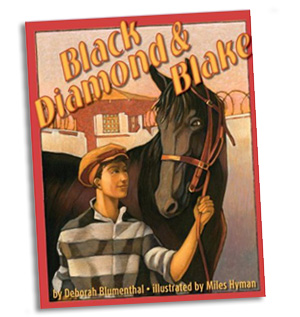
by Deborah Blumenthal
with illustrations by Miles Hyman
Knopf Books for Young Readers
Order now from IndieBound.org
Order now from Amazon.com
Order
now from Barnes&Noble.com
REVIEWS
School Library Journal
Black Diamond, a prize racehorse, is sold to a prison horse-care program after he is injured and can no longer compete. He feels abandoned by the human family he has always worked to please, but he gets a second chance at happiness when he meets Blake, the inmate chosen to care for him through the rehabilitation program. The two form a close bond, but then Blake finishes his sentence and Black Diamond’s care is given over to two insensitive inmates. “For days, weeks, and months, Black Diamond looked for Blake.” Just when the horse has given up hope, the man returns with enough money to purchase him and take him home. Beautiful dry pastel illustrations in warm tones harken back to a time of Art Deco, the Golden Age of cinema, and WPA murals. Told from the perspective of Black Diamond, the sensitive story sometimes borders on sentimentalism, but it is genuinely moving, so these moments are easy to forgive. This unique tale, distinctly set in the past and based on actual contemporary work-rescue programs, offers children a vision of hope for the discarded animals and humans of our society.
–Madeline Walton-Hadlock, San Jose Public Library, CA
Booklist
Telling the story of an imaginary racehorse named Black Diamond, presumably in the 1920s or 1930s, this
picture book is a nostalgic and touching tale of second chances inspired by real events. After losing his
winning edge, Black Diamond is shipped off to a prison, where inmates are offered the opportunity to care
for and look after animals. Blake (in prison for the hard-to-blame act of stealing to help his family) forms a
special bond with Black Diamond, but then is released and forced to leave the horse in the cold and
sometimes abusive care of other inmates. Eventually, Blake returns for Black Diamond and takes the horse
to his new home. The soft-focus art features quaint scenes of Black Diamond’s journey from the track to a
home, anchored by a strong sense of a bygone time. Telling the story from the horse’s point of view meets
with middling results, but the human-animal bond is a timeless theme and will evoke empathy in children.
Even if they aren’t horse lovers to begin with, they’ll be touched by the sentimental ending.
—Ian Chipman
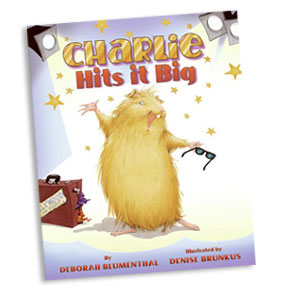
by Deborah Blumenthal
with illustrations by Denise Brunkus
HarperCollins
Order now from IndieBound.org
Order now from Amazon.com
Order
now from Barnes&Noble.com
REVIEWS
Barnes & Noble
Charlie is a pint-sized guinea pig with Tinsel Town dreams. Most of us know that stardom doesn't come easy, but Charlie is convinced that his rodent good looks and toothy smile make him a surefire candidate to be the next Tom Hanks or Tom Cruise. But what fate awaits him? We won't ruin the story, but we will say that writer Deborah Blumenthal and illustrator Denise Brunkus have concocted a story that will warm the cockles of your heart.
Children's Literature
The story of Charlie the guinea pig, who, after seeing a newspaper clipping in his cage about pigs making it big in Hollywood, leaves his family for his own chance at stardom. Once there, Charlie slightly impresses a casting director with his very emotional reading of the lines. However, the casting director is looking for dark and handsome. So tan furred Charlie dyes his hair dark and returns to truly impress. The casting director telling him that he’s going to be “Big!” After being exposed to hordes of flashing light bulbs from photographers and almost getting stepped on by people numerous times at his first Hollywood party, Charlie begins to miss the comforts of home: playing with his owner, Sophie, no pushy people, and his favorite treat Fruity-Nut Buffet. With these thoughts in his mind, Charlie hightails it back home and into the welcome arms of Sophie, who is more than happy to see him. Though the age is listed as good for 3- to 8-year-olds, it is more appropriate for 3- to 6-year-olds. The illustrations are big, bright, and colorful. Charlie’s want of the creature comforts of his home vs. the attention of Hollywood make a good point that sometimes simple things are the best.
Reviewer: Patrick Hunter
School Library Journal
PreS-Gr 1- When a shocked Sophie finds that Charlie, her guinea pig, has escaped from his cage, she's unaware that the errant rodent has decided to make his fame and fortune in Hollywood. He flies cross-country first class, gets a part in a movie, and begins to lead the glamorous life of a star. Before long, though, he realizes that the glitz isn't for him and, homesick, he returns to his family. In this classic tale of the allure of bright lights, the sassy little rodent has chutzpah to spare. The candy-colored illustrations are lighthearted and have a sure, "stop action" frenzy; funny bits are woven into each spread, featuring the diminutive guinea pig amid the over-the-top splendor of a star's world.
-Marge Loch-Wouters, Menasha Public Library, WI
Copyright 2008 Reed Business Information.
Kirkus Reviews
What's a guinea pig with dreams of movie stardom to do? If it's Charlie, Sophie's pet, he sneaks away from the human family's home and heads off to Hollywood. People understand his speech and he is able to hail cabs and be dressed by the snazziest designers. (Clearly a strong suspension of disbelief is required.) In order to get the starring role in a Beauty and the Beast-type film he dyes himself dark brown (all the better to be small, dark and handsome, you see). Charlie is feted and fawned over by the humorously drawn sycophantic Hollywood crowd yet finds himself feeling lonely and dissatisfied. Now what's a homesick guinea pig to do? Hop a plane back to young Sophie, of course. Brunkus, the illustrator of the popular Junie B. Jones series, adds a great deal to the silly text via her funny, colorful and enlightening drawings. Easily conveying Charlie's hubris followed by his attainment of just a little bit of humility. (Picture book. 4-7)
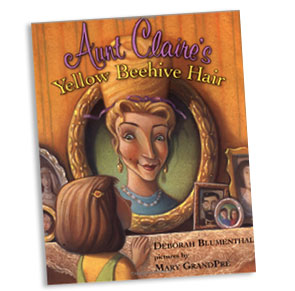 Aunt
Claire's Yellow Beehive Hair
Aunt
Claire's Yellow Beehive Hair
by Deborah Blumenthal
with illustrations by Mary GrandPre
Pelican Publishing
Order now from IndieBound.org
Order
now from Amazon.com
Order
now from Barnes&Noble.com
REVIEWS
Publishers Weekly
"This volume is not so much about Aunt Claire or her hair as it is about the telling details that set each of young Annie's family members apart. Annie longs to know about her ancestors:
'I want to reach into the past and bring them closer to me.'
With the help of her great-aunt, she does just that, sorting through photographs as well as such memorabilia as yellowed letters with faded handwriting and the lace wedding veil worn by her Swedish Great-Grandma Sophie. GrandPre effortlessly breathes life into these snippets of lives well lived. For instance, in a sepia-toned photograph, dashing Great-Grandpa Louis, who bet on horses, looks flirtatiously over at his wife, conveyed in a dreamy, smoky-blue image on the opposite page, who clearly returns his affection:
"Great-Grandma Sadie stayed home/ and sewed tiny silver sequins onto dresses/ and baked twisted breads/ to make back the money/ that Great-Grandpa Louis lost."
Blumenthal (The Chocolate-Covered-Cookie Tantrum) and GrandPre‚ create an anecdotal album within an album, making bygone times shine brightly for both the heroine and readers. The artist (best known for the cover art and interior spots for the Harry Potter novels) whimsically mingles images of past and present in radiant pastel paintings, which range from comical to affecting.
A family portrait to savor, this may well spark kids' interest in their
own family trees.
Ages 5-up."
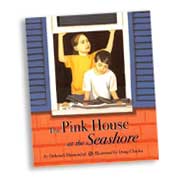 The
Pink House on the Seashore
The
Pink House on the Seashore
by Deborah Blumenthal with illustrations by Doug Chayka.
Clarion Books for Young Readers
Order now from IndieBound.org
Order now from Amazon.com
Order
now from Barnes&Noble.com
ABOUT THE BOOK
A house can be more than just a shelter. Some houses are places where
family traditions grow, where memories live. But what happens to the traditions
and memories when the house is gone? After losing a beloved summer home
to a treacherous storm, two children and their parents discover the affirming
answer to this poignant question . . . together. Evocative paintings and
spare text show the family combing the sand for fragments of their possessions,
sharing memories, and beginning to look beyond their loss.
Booklist
K-Gr. 3. After a storm destroys her family's summer cabin at the beach,
a girl tells of driving back there with her parents and her brother. Simple,
evocative words and expressive gouache pictures show the destruction they
find: "a world / shaken, / turned upside down, / inside out / by
shrieking winds" that "had ripped along the coast / like a mad
beast, / destroying everything in its path." The sorrow is heartfelt.
The girl remembers happy times when the family felt safe. She talks about
her present grief and loss, and, finally, about the hope of rebuilding,
even as she hears her mother cry. Of course, the horrifying tsunami images
and the reports of local storms and destruction will add immediacy to
this story, which can open discussion about both the nightmares of sudden
natural disasters and the loss of this one family--fortunate that its
loss was not a loved one.
Hazel Rochman
Copyright © American Library Association. All rights reserved
Kirkus
In the aftermath of a hurricane, a family returns to the site of its seashore
vacation cottage to find "a world shaken, / turned upside down, /
inside out." The small house that has been in the family for generations
is now "only broken boards / and splinters of pink wood." The
children search in the sand "for pieces of a lost time." The
spare language, set in short, uneven lines, captures the shock, the sense
of loss and the grief experienced by the family, as well as the sense
of freedom that comes from creating something new. The family spends the
next summer in a red tent upon which they paint blue shutters, a structure
the children imagine is many things-a hospital, the Big Top and a base
camp in Antarctica. Upon returning home, the children take their "make-believe
house" with them, setting it up in the living room, where they "dream
about summers to come." Chayka's broadly executed, colorful gouache
illustrations effectively express the poignant mood of this lovingly told
story that will resonate for anyone who has suffered a life-transforming
loss.
(Picture book. 6-10)
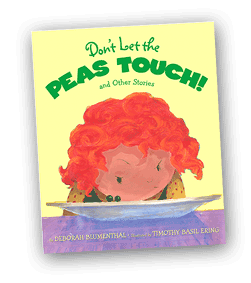 Don't
Let the Peas Touch!
Don't
Let the Peas Touch!
and Other Stories by Deborah
Blumenthal
with illustrations by Timothy Basil Ering
Arthur A. Levine Books/Scholastic, October, 2004
Order now from IndieBound.org
Order
now from Amazon.com
Order
now from Barnes&Noble.com
A Book of the Month Club Alternate
Book Sense 76 Winner, Winter 2004
REVIEWS
Starred Review:
Bulletin of the Center for Children’s Books (Champaign, IL)
Three personable stories chronicle the authentically thorny relationship between Sophie and her older sister, Annie. In the first story, Annie’s culinary display falls afoul of Sophie’s determined pickiness; in a second, Sophie’s good intentions aren’t enough to achieve the quiet time Annie requests; finally, Annie makes up for a mean big-sister remark with a surprise pet that she and Sophie can share. These gently shaped slice-of-life stories fairly vibrate with personality and that personality is usually that of forceful little Sophie, whether she’s holding her meat up to the light in wary search of fat and gristle or helpfully leading her toy animals in a very quiet circus while her sister studies. Sprightly natural dialogue captures the true, not always fond, tone of sisterly exchanges, and careful word choice makes the simple sentences a quiet triumph of rhythmic exposition. Mixed-media illustrations rely mostly on strong acrylic pigments, often textured with scrawls of grease pencil; Sophie’s redder-than-red curls draw the eye in most illustrations, but they’re well balanced with a delicious buffet of spicy touches and cool colors, standing out against softly muted backgrounds. The vivid colors and changing layouts, ranging from spot art to vignettes to spreads, provide a rollicking visual cadence, while the sharp lines of faces add emotional punctuation to the scenes. The three-chapter format allows the readaloud pleasure to be drawn out over several sittings, and beginning readers brave enough to tackle occasionally creative font will also enjoy this sisterly literary outing.
Kirkus
Siblings clash, then resolve their issues without parental meddling in these three child-centered episodes. Preschooler Sophie rejects every dish her preteen sister Annie tries to serve for a cooking class, then does her best to give Annie a quiet time (with notable lack of success), and finally receives a low-maintenance “pet” –a seed she dubs “Tiny”—of her very own. Blumenthal drolly captures the sisters’ disparate personalities—and so does Ering, depicting patient (but not unreasonably so) Annie with sensibly neat brown hair and Sophie as an unruly redhead. She’s flopped back in her chair with an expression of comical disgust when Annie proudly uncovers “Ze best blue cheese omelet!,” absorbedly constructing a doomed “very quiet, very tall house” from blocks, and at last, dancing delightedly on her bed when Tiny undergoes an overnight transformation. Here’s a right-on picture of a close, if not always smooth, relationship that will make knowing readers grin.
Publisher's Weekly
Three brief tales of two sisters add up to one warm and wise picture book.
Annie and her younger sister, Sophie, are as different as can be. Annie
loves to cook and try new foods while Sophie is a picky eater who doesn't
like any of the foods on her plate to touch. Though Annie likes to take
quiet time to read, Sophie has trouble keeping things at a whisper. And
Annie is old enough to be keeper of the family pet, but Sophie's pleadings
to get another household critter largely fall on deaf ears. As readers
get to know these energetic girls, they'll likely relate to the universal
themes here: sibling rivalry, age-appropriate responsibility and good
old-fashioned, bratty bickering. Through it all, though, Blumenthal (Aunt
Claire's Yellow Beehive Hair) sounds a realistic, reassuring note in the
form of supportive, if sometimes exasperated, parents, and sisters who
eventually learn to compromise while showing flashes of their love and
concern for one another. Ering's (The Tale of Despereaux) mixed-media
art featuring bright acrylics, ink and pencil, have zing. Sophie's fiery
red locks and attention-getting antics make her a natural focal point-and
a memorable interruption in the everyday rhythms of a typical family's
routine. Ages 4-8.
(Oct.) Copyright 2004 Reed Business Information.
School Library Journal
Kindergarten-Grade 2–The trials, tribulations, and triumphs of
sisterhood are perfectly captured in this trio of tales. In the first,
big sister Annie is applying her newly acquired cooking skills but little
sister Sophie has a set of culinary rules all her own. "The peas
are touching the eggs! Don't let them touch!" A frustrated Annie
uses some ingenuity and a lazy Susan to save the day. In the second vignette,
Annie needs some quiet time and Sophie tries (but fails) to oblige. Both
girls plumb their flexibility, imaginations, and affections when Annie
introduces Sophie to a unique and ultimately satisfying pet in the final
story. The personalities of these sisters shine throughout this well-paced,
lengthy picture book. Sophie is, at times, a tiny termagantbut also an
avid admirer of Annie, who is often exasperated by but truly cares for
her exuberant sibling. Their dialogue realistically veers from gentle
compassion to shouted insults. The pencil, pen, and, acrylic illustrations
are lively and winsome and the cheerful palette reflects the upbeat tone.
Moments of high drama explode across the page and eyebrows speak volumes
in Ering's witty artwork. The dynamics of sibling relationships, both
mundane and meaningful, are expertly captured so expect some heartfelt
sighs from both adult readers and young listeners alike.
–Carol Ann Wilson, Westfield Memorial Library, NJ
Copyright Reed Business Information, a division of Reed Elsevier Inc.
All rights reserved.
ABOUT THE BOOK
All's fair in war and peas...or is it? Meet Sophie and Annie, little sister and big. Read three stories about how they fight and make up becuse Sophie is a picky eater and Annie isn't, Sophie likes to make noise and Annie doesn't, Sophie wants a pet and Annie...well, surprises her. Kids everywhere will recognize their problems and laugh at the solutions in this smart, funny book.
 Ice
Palace
Ice
Palace
by Deborah Blumenthal
with illustrations by Ted Rand
Clarion Books for Young Readers
Order now from IndieBound.org
Order now from Amazon.com
Order
now from Barnes&Noble.com
REVIEWS
School Library Journal
"Kindergarten-Grade 4-A girl describes the annual winter carnival
in Saranac Lake, NY.* Its centerpiece is an enormous ice palace, constructed
in recent years not only by villagers, but also by crews from Camp Gabriels,
a nearby minimum-security correctional facility. Each day, the 10-year-old
and her father watch the building progress, block by block, with slush
used as mortar. When the opening day finally arrives, it is a whirlwind
of parades, games, races, and the crowning of a king and queen, culminating
in spectacular fireworks. As the book ends, winter fades into spring,
the ice palace melts away, and the child is left thinking about her Uncle
Mike, one of the prisoners who helped construct the castle. He is due
to be released and will perhaps participate freely in next year's activities.
The text is poetic yet approachable. The description of the prison is
straightforward without being alarming; it is "a place that keeps
men away from other people for a while because they've broken the law."
Rand's watercolor-and-acrylic illustrations capture the icy-blue feel
of a small town in winter, with the brush strokes providing texture and
layer to the story. Children will be fascinated by this unusual tradition,
and the girl's personal relationship to one of the workers draws readers
deeper into the tale."
* Want to learn more about the real Saranac Lake Winter Carnival? Visit
the website:http://www.saranaclake.com/carny.shtml.
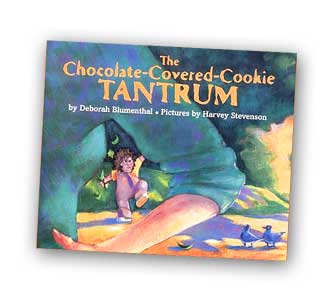 The
Chocolate-Covered-Cookie Tantrum
The
Chocolate-Covered-Cookie Tantrum
by Deborah Blumenthal
with illustrations by Harvey Stevenson
Clarion Books for Young Readers
Order now from IndieBound.org
Order now from Amazon.com
Order
now from Barnes&Noble.com
REVIEWS
School Library Journal
"A slice-of-life picture book that acknowledges the intense emotions of a toddler. On the way home from the park, Sophie spots another child eating a chocolate-covered cookie. 'I want a cookie,' she says pointing a stubby finger, 'I want that cookie.'
Despite her mother's calm and logical response, Sophie becomes more and more upset, finally launching into a tantrum that involves kicking, screaming, tears, and a face as 'hot as a pepper.'
The straightfoward and simply worded text uses repetition to express the child's fury, frustration, and helplessness. Both words and pictures capture the sudden and surprising intensity of the tantrum, and the reassuring comfort of recovery."
Copyright Deborah Blumenthal 2011. All Rights Reserved.